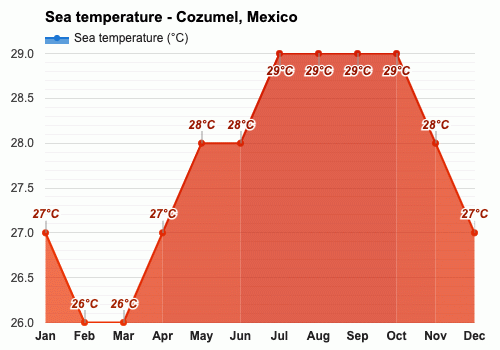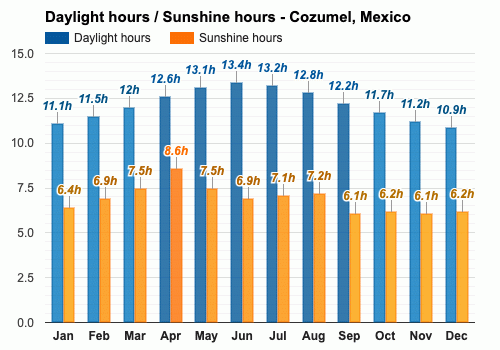
Weather in July
Temperature
The commencement of July brings an average high-temperature of a still hot 32.6°C (90.7°F), marking an inconsequential divergence from June. Cozumel records a steady low-temperature average of 23.5°C (74.3°F) during July.Heat index
July's mean heat index is estimated at a burning hot 49°C (120.2°F). Caution: Heat cramps along with heat exhaustion are expected. Sustained activity could lead to heatstroke.In reference to the heat index, it's for places in shade and with a slight wind. Heat index values have the potential to be boosted by 15 Fahrenheit (8 Celsius) degrees due to direct sunlight.
Note: The heat index, also known as 'apparent temperature' or 'real feel', gauges the sensation of temperature factoring in the air's moisture content. This effect is personal, influenced by the individual's physical activity and heat sensitivity, shaped by factors including wind, attire, and metabolic variations. In the direct sunlight, the weather's impact can be amplified, possibly boosting the heat index by up to 15 Fahrenheit (8 Celsius) degrees. Heat index values hold particular significance for children. Young kids are often more at risk than adults as they tend to perspire less. Besides, their skin surface is larger relative to their small bodies, and their increased heat output from their active lifestyle compounds their risk.
Evaporation of sweat is the main factor behind the cooling effect of perspiration in the human body. Relative humidity in excess curtails evaporation, therefore reducing heat dissipation from the body, leading to feelings of excess heat. If heat absorption isn't effectively countered by the body's cooling methods, body temperature surges, hinting at potential problems.
Humidity
In Cozumel, the average relative humidity in July is 84%.Rainfall
In Cozumel, in July, during 11.8 rainfall days, 116mm (4.57") of precipitation is typically accumulated. Throughout the year, there are 119.9 rainfall days, and 1490mm (58.66") of precipitation is accumulated.Sea temperature
July through October, with an average sea temperature of 29°C (84.2°F), are months with the warmest seawater.Note: For swimming, diving, and other water activities, temperatures between 25°C (77°F) and 29°C (84.2°F) are perceived as very enjoyable and pleasurable for prolonged periods without feeling uncomfortable.
Daylight
In Cozumel, the average length of the day in July is 13h and 14min.On the first day of the month, sunrise is at 6:11 am and sunset at 7:32 pm. On the last day of July, in Cozumel, sunrise is at 6:22 am and sunset at 7:25 pm EST.
Sunshine
The average sunshine in July is 7.1h.UV index
April through August, with an average maximum UV index of 12, are months with the highest UV index. A UV Index reading of 11, and higher, represents an extreme threat to health from exposure to the Sun's UV radiation for the average person.Note: An average maximum UV index of 12 in July leads to these recommendations:
Enforce every vital precaution. Those with light skin could endure burns in a matter of minutes. During the period from 10 a.m. to 4 p.m., UV radiation is highest. Try to avoid direct sunlight during these hours. Clothes that are both tight-knit and comfortably loose are prime choices for sun protection. Apply and frequently reapply a broad-spectrum SPF 30+ sunscreen after every two hours, or immediately after a swim or outdoor exercise. Note! Reflective surfaces like sand and water heighten the UV radiation levels.
Published by: Weather Atlas | About Us
Data Sources | Weather Forecasting & Climate
Frequently asked questions
How hot is it in July?
What is the average humidity in July in Cozumel?
How many days does it rain in July in Cozumel?
When is the sea warmest?
How warm is the water in July?
How many hours of daylight does Cozumel have in July?
When are sunrise and sunset in July?
How many hours of sunshine does Cozumel have in July?
What are the months with the highest UV index?
What is the UV index intensity in July?
Average temperature in July
Cozumel, Mexico

- Average high temperature in July: 32.6°C
The warmest month (with the highest average high temperature) is August (33°C).
The months with the lowest average high temperature are January and December (28.6°C).
- Average low temperature in July: 23.5°C
The month with the highest average low temperature is June (23.8°C).
The coldest months (with the lowest average low temperature) are January and February (19.4°C).
Average humidity in July
Cozumel, Mexico

- Average humidity in July: 84%
The month with the highest relative humidity is September (87%).
The months with the lowest relative humidity are March and April (79%).
Average rainfall in July
Cozumel, Mexico

- Average rainfall in July: 115.5mm
The wettest month (with the highest rainfall) is October (242.5mm).
The driest month (with the least rainfall) is March (32.2mm).
Average rainfall days in July
Cozumel, Mexico

- Average rainfall days in July: 11.8 days
The month with the highest number of rainy days is October (15.7 days).
The month with the least rainy days is April (3.7 days).
Average sea temperature in July
Cozumel, Mexico

- Average sea temperature in July: 29°C
The best months for swimming (with the highest average sea temperature) are July, August, September and October (29°C).
The coldest months (with the lowest average sea temperature) are February and March (26°C).
Average daylight in July /
Average sunshine in July
Cozumel, Mexico

- Average daylight in July: 13h and 1min
The month with the longest days is June (Average daylight: 13h and 24min).
The month with the shortest days is December (Average daylight: 10h and 54min).
- Average sunshine in July: 7h and 1min
The month with the most sunshine is April (Average sunshine: 8h and 36min).
The months with the least sunshine are September and November (Average sunshine: 6h and 6min).
Average UV index in July
Cozumel, Mexico

- Average UV index in July: 12
The months with the highest UV index are April, May, June, July and August (UV index 12).
The months with the lowest UV index are January and December (UV index 7).
Cozumel, Mexico
Weather forecast for your location
2. Allow the app to use your location


